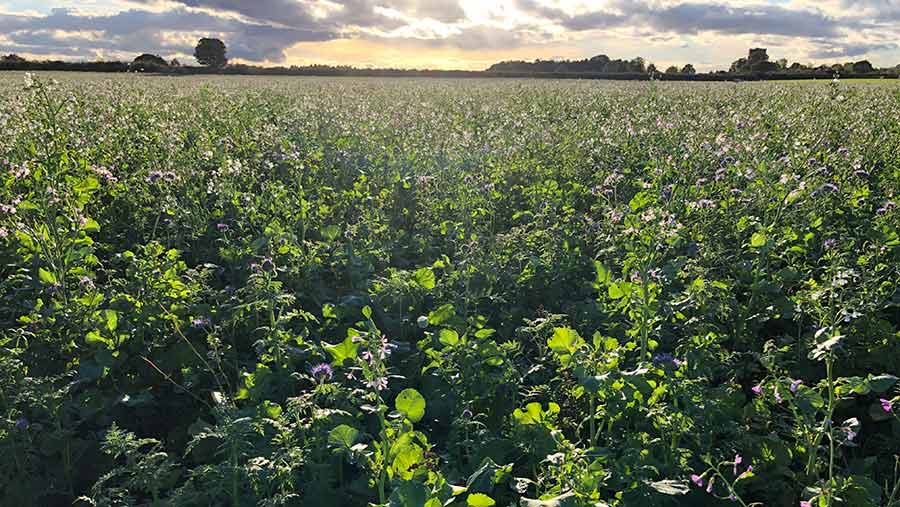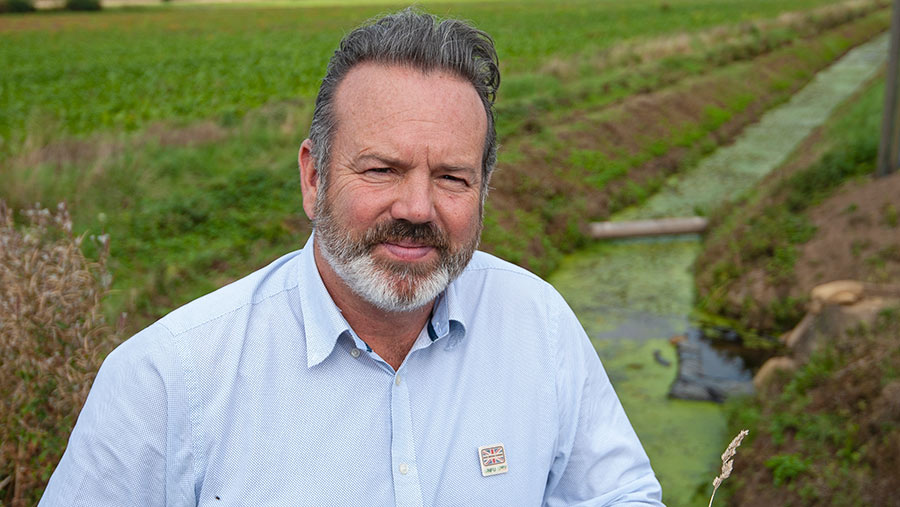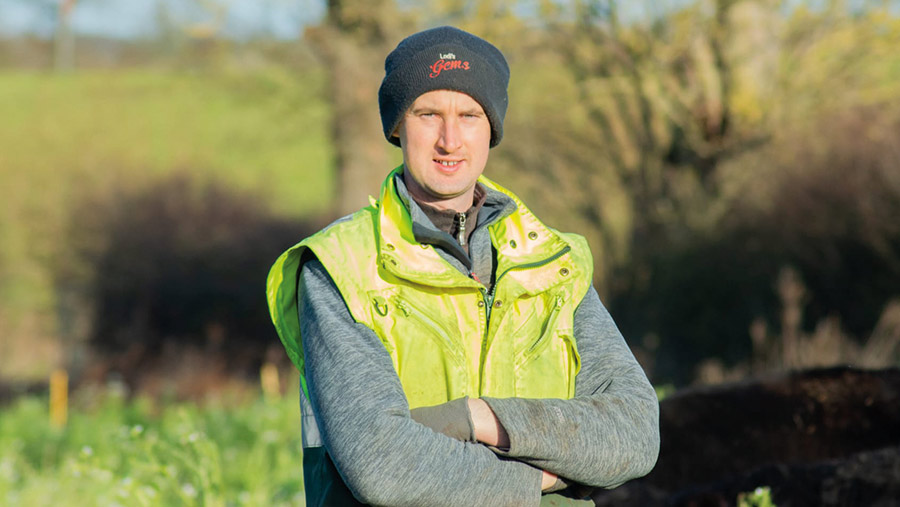4 growers’ methods of effective cover crop destruction
 © Richard Bramley
© Richard Bramley Cover crops are becoming a mainstream option for growers, but their effective removal is critical to get good spring crop establishment.
Farmers Weekly speaks to four growers from across the country to find out what methods work for them and why.
See also: How to achieve the most effective cover crop destruction
Glyphosate and roller
David Lord, Earls Hall Farm, north-east Essex

© David Lord
Farming 600ha on the Essex coast, David Lord’s predominant method for cover crop removal is glyphosate, although the use of a roller on a frosty early morning has also proved successful.
All land going into the winter is planted to a cover crop mix of radish, vetch, clover, phacelia, buckwheat and mustard, alongside volunteers of either spring oats, barley or wheat.
Glyphosate is the go-to option, aiming to spray off eight weeks before drilling, depending on crop thickness and weather conditions.
“If drilling in mid-March, we aim to spray mid-January, but when growing crops such as linseed, canary seed or spring OSR, we leave this gap a little longer,” he says.
He uses a standard glyphosate rate of 3.5-4 litres/ha, in one solo hit.
If there is a hard frost, Mr Lord uses a roller to kill the crops in the early morning hours.
“The frost knocks the crops back and the roller kills the crops by snapping them at the growing point. It kills any broad-leaved crop immediately, but it doesn’t kill grassweeds, hence the need for glyphosate,” says Mr Lord.
Rolling has been used twice in the past six years and proved effective. However, farming by the coast means this is not always practical as temperatures of -4C or lower is required.
For cover crops grown before potatoes, the flail is sometimes used in front of the cultivator, particularly where there is significant cover biomass.
He admits this is an expensive and intensive operation, but the benefits from the cover far outweighs the cost of flailing.
Mr Lord also trialled grazing with sheep and is part of the England Steering group for the Nature Friendly Farming Network.
Flailing and cultivating
Richard Bramley, Manor Farm, York

© Richard Bramley
Yorkshire grower Richard Bramley aims to destroy his cover crops without glyphosate. He instead relies on flailing and cultivating to terminate covers, ahead of sugar beet and potato drilling.
Cover removal takes place from late February to early March, weather dependent. Particularly tall, dense and woody crops, measuring over waist height, are flailed three to five weeks before drilling.
“Flailing is beneficial,” says Mr Bramley. “It doesn’t kill the crop outright and instead keeps living roots in the ground to enable the slow breakdown of crop biomass.”
For shorter, leafier crops he runs through with a set of discs, just enough to tickle the surface and cut through the stems and leaves.
However, in some situations, if there is a particular weed issue where brome, docks or grassweeds begin to creep into the field from grass margins, half a boom spray width of glyphosate is used on headlands before planting.
He then goes through with the plough in the third week of March ahead of sugar beet and late March for potatoes.
Cover cropping has been used at 230ha Manor Farm since 2007, mainly to improve the farm’s soil health and to bring valuable benefits to farm biodiversity, with a range of flowering species providing nectar for pollinators.
Mr Bramley includes a multiresistant oil radish to the mix of the variety Defender. This provides a degree of potato cyst nematode control through its biofumigation properties.
“Since the introduction of cover cropping, the impacts of free living nematodes issues, which were particularly problematic in winter barley crops, have gradually reduced and now almost disappeared over time,” he says.
Despite the variety’s greater expense, it offers further benefits such as no stimulation of clubroot, something that is particularly important with oilseed rape in the rotation.
Sheep grazing/glyphosate
Ben Adams, Lower Farm, north Oxfordshire

© Ben Adams
Ben Adams started cover cropping five years ago, with a small area grown as an ecological focus area green cover.
Fast-forward to today and he now plants all of Lower Farm’s spring cropping area (40%) ahead of a nine-way mix, costing £26.61/ha.
Farming 400ha of arable near the town of Bicester, Mr Adams made the most of the plethora of graziers to help terminate his covers by teaming up with two local shepherds.
“We now get all the benefits of having sheep on the farm, without the ties of owning them ourselves,” he says.
Sheep graze the covers comprising of oil radish, buckwheat, phacelia, quinoa, vetch, millet, oats, linseed and peas for three months.
This commences in mid-November, slightly later than usual as this allows time for frosts to kill-off the buckwheat, which can otherwise be toxic to sheep.
Grazing takes place on a field-by-field basis and is complete by January. Mr Adams aims to graze one-third, trample one-third and leave one-third as residue on the surface for slow decomposition into the soil.
“The key is not to leave the sheep on too long, as poaching can be an issue on clay loam headlands. Also plant covers at a relatively low seed rate of 15-20kg/ha to allow blackgrass to germinate within the cover and not lie dormant.”
As most of the biomass is removed by the sheep, the ground is left to rest before spraying with glyphosate at a rate of 2.5-3 litres/ha, depending on the weed pressure.
This takes place one week before drilling where land is to be planted to either spring wheat, spring linseed or oats and peas.
A splash of humic or citric acid is added to glyphosate, acting as a cost-effective adjuvant by reducing the spray’s pH. Where cranesbill is an issue, herbicide 2,4-D is added to the tank.
Mr Adams notes that he considered alternative destruction methods such as crimping and rolling due to the good selection of frosts, but sheep grazing proves an effective method and brings in a small diversified income of £10-£20/ha.
Next autumn, he plans to include a 12-way species cover mix, while reducing the cost to less than £25/ha by using more home-saved seed.
Cattle and sheep grazing/ploughing and glyphosate
Sam Bales, Somerleyton Farms, Norfolk/Suffolk border

© Liam Symonds
Terminating cover crops with cattle and sheep is a fundamental farming technique at Somerleyton Farms, proving beneficial for both livestock and arable enterprises.
“Grazing has real benefits,” says livestock manager Sam Bales. “It increases forage availability, eliminates housing costs and improves health of both the livestock and soil.”
Although he admits it is quite labour intensive, so finding the right staff is key.
The farm currently has just shy of 100ha of cover crops, which are all grazed off by 250 Welsh Black cattle and 350 sheep, before planting potatoes, sugar beet, spring barley or onions.
Covers were first introduced in 2013, mainly oil radish and forage rape, planted ahead of sugar beet to provide additional sheep grazing.
Since then, the mixes have been tweaked to also include linseed and clover, as well as a separate turnip and forage rape mix.
Cattle begin grazing in early November and sheep a little earlier. Livestock are strip-grazed in separate paddocks, with a total of three groups of cattle and three groups of sheep.
Depending on the regrowth of covers, a second graze with sheep can follow after cattle – particularly in mixes with a high proportion of radish and forge rape.
Livestock are usually off the covers and moved to marshland by 1 April, but this can vary considerably as marshland requires sufficient time to dry out after winter.
Land planted to sugar beet is then ploughed, while areas destined for potatoes and onions receive an application of glyphosate followed by a pass with the Vaderstad cultivator.
Mr Bales admits that the glyphosate spray could be avoided, but as potatoes and onions are let out to a third party, there is no room for faults.
“Fields going to spring barley are sprayed off and receive a pass with the Vaderstad. We have considered direct-drilling into the covers, but as cattle have been on the land, a small cultivation benefits the following crop establishment,” he says.

